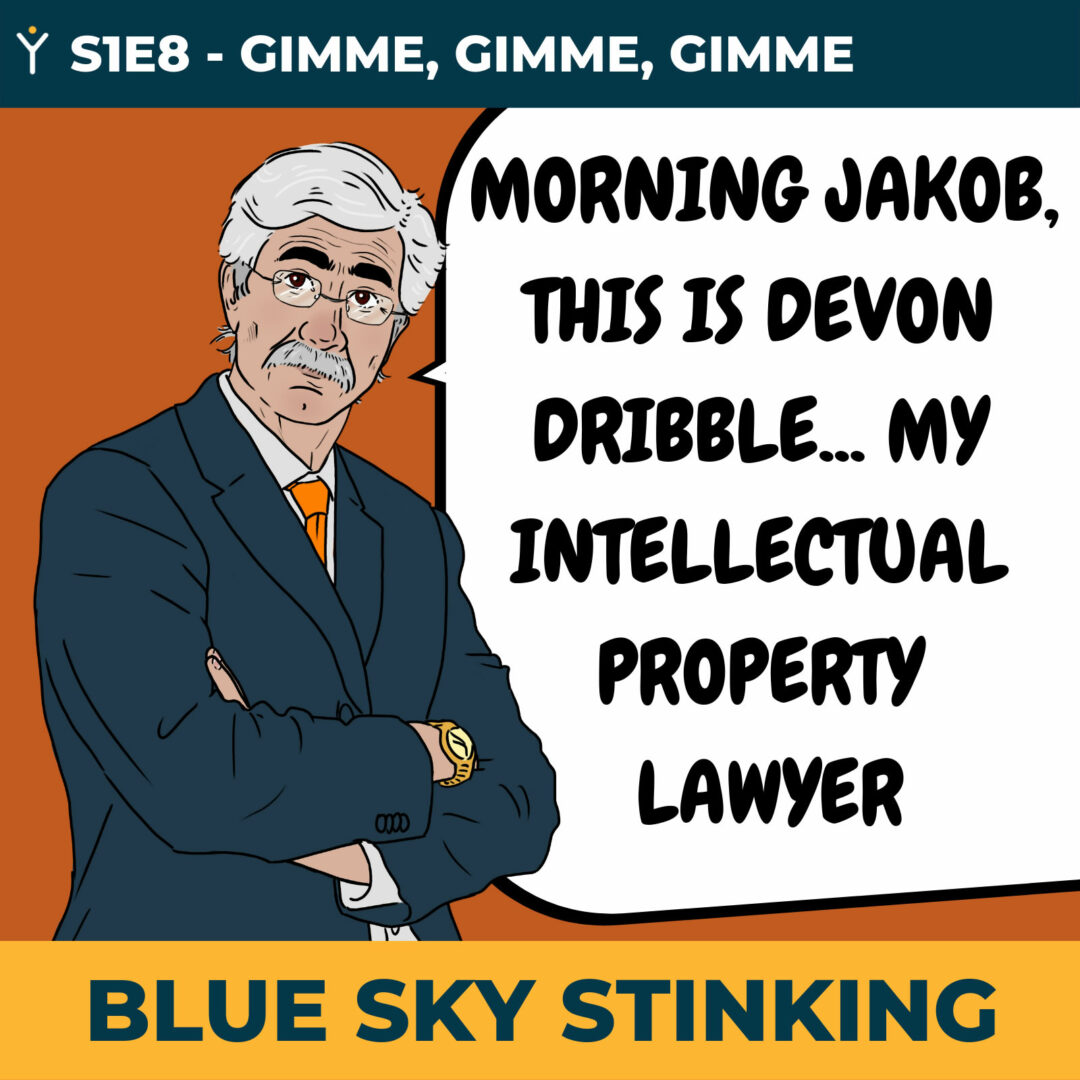

What happens when one company uses the designs of a product that is properly protected? What happens if you don’t have intellectual property protection in place? Mike talks to Jacob Cunningham from Bright Solicitors to get some valuable guidance on what all organisations should be considering in relation to thier less tangible assets.
Timings
- 00:20 - Scene 8.1 - Patently Obvious
- 02:56 - Scene 8.2 - Rock and a hard place
- 06:34 - Discussion with Jacob Cunningham, Bright Solicitors
- 08:21 - What is Intellectual Property (IP)
- 09:03 - Types of Intellectual Property rights
- 10:18 - Who owns intellectual property
- 11:28 - Why protect the things that you've created?
- 12:45 - Benefits when buying or selling a business
- 13:27 - Examples of where IP has been a problem
- 14:50 - Dangers of copying on-line documents
- 16:00 - Risks surrounding Intellectual property
- 17:45 - What should Sydeline have done?
- 20:05 - The Patent Tests
- 21:43 - Can you Patent software?
- 22:52 - Next steps for Sydeline on the matter of the Patent?
- 24:40 - Top Tips for those who've never considered their IP
- 26:00 - Watch what your using from the internet
- 27:57 - What's next?
Useful Information
Researching existing registered IP (@00:00)
Intellectual property guidance (@00:00)
Top tips for ...(@00:00)
- Undergo an IP Audit - Get someone to help
- Become familiar with the guidance
- Take advice from an IP professional
- Simple patent validation test
Episode script
CONTINUITY: Zelda and Jakob stand and watch as the factory starts to output the first saleable products.
JAKOB: Well, that’s a sight for sore eyes
ZELDA: (whist-fully) Isn’t it though
JAKOB: Took quite a bit to get it to production. Really not sure why we didn’t get another company to do the manufacturing
ZELDA: This is our product. Our production, our people, our ideas, our innovation, our profits
JAKOB: My money
ZELDA: Our money! Remember I have used nearly all my savings
JAKOB: And the mortgage on your apartment?
ZELDA: In time, if needed, when you run out
BRYOCK: (approaching) Ms Zero
ZELDA: You can call me Zelda, Bryock
BRYOCK: (quote time) “There can be no prestige without mystery, for familiarity breeds contempt.”
JAKOB: Who said that?
BRYOCK: Charles De Gaulle
JAKOB: Gotta love the French!
BRYOCK: Ms Zero, you have had this in todays actual mail. Haven’t seen many before, but I think it’s a letter
ZELDA: Very funny, what is it?
BRYOCK: It appears to suggest that you are in violation of the Patents Act
JAKOB: What? Give that here. It’s from Dribble and Froth – aren’t they your dads legal troop?
ZELDA: Rings a bell, what are they saying?
JAKOB: They say that “It has been brought to our attention that you have commenced production of a product based on a registered patent without licence, agreement or consideration”
ZELDA: What the hell?
JAKOB: I knew it. When he said you’d nicked his product, I should have pinned him down then.
ZELDA: When was that?
JAKOB: You know, that night he invited us over for a meal together… I KNEW IT! What an idiot
ZELDA: But he’s my dad
JAKOB: He’s teaching you a lesson
ZELDA: He’s my dad
JAKOB: He’s been a businessman longer
ZELDA: My dad!!
JAKOB: Look, there’s probably been a bit of a misunderstanding or this is a really bad prank
ZELDA: Dad!!!
JAKOB: I think you may be in shock. Bryock, could you take… Ms Zero…to her office please and get her a drink. Keep an eye on her – I’ve got to take a stroll to Zero’s.
CONTINUITY: Jakob enters the offices of Zero’s Heroes. However, he is unable to walk straight up to Nero’s office, instead having to present himself to a receptionist
JAKOB: (surprised and hesitant) Oh, hello…I’d like to see Mr Zero please
RECEPTIONIST: Do you have an appointment?
JAKOB: *sigh* No, no I don’t – would he be free now, he usually doesn’t book anything around Pop Master
RECEPTIONIST: I will phone up and check. May I ask your name please
JAKOB: (through gritted teeth) Jakob Oakstock
RECEPTIONIST: (On the phone) Hi Lucy, is Mr Zero available to see a Mr Jakob Oakstock… Sure, I’ll wait… Uh huh, yep, ok, I’ll tell him. (Talking to Jakob) Mr Zero will see you at 10:45, if you could wait. Can I get you a drink of some kind?
JAKOB: (still through gritted teeth) No thank you
(Tick tock)
RECEPTIONIST: You may go up now Mr Oakstock, Mr Zero is in his office – I understand you know the way.
JAKOB: Yes, yes I do…Thank you
(Knock, knock, knock)
JAKOB: Nero, What is the intention of… (Sees someone else is un the office with Nero) Oh, hello.
NERO: Morning Jakob, this is Devon Dribble. She’s my Intellectual Property lawyer
DEVON: Yes, yes, we at Dribble and Froth work tirelessly to protect the patents of Zero’s Heroes along with helping with Trademarking, copyright law and the like.
NERO: Devon, this is Jakob Oakstock. He and Zelda Zero own Sydeline.
DEVON: Oh yes, yes, yes. We have just written to you about a breach we spotted.
JAKOB: Breach?
DEVON: Yes, yes – We noted from your marketing material that you were using one of Mr Zero’s patented designs and we sent you a letter to that end
JAKOB: I noticed (waving the letter in the air)
NERO: You see, I’ve just got back from conference and Dribble and Froth have authority to act on my behalf to protect the assets of Zero’s Heroes.
DEVON: Yes, yes, Once we had found the evidence of a breach, we launched an investigation and sent you the letter. We also advised Zero’s Heroes to tighten their visitor security.
JAKOB: (deliberate) You were aware that YOUR DAUGHTER was repurposing the design Nero
NERO: Yes, I was
DEVON: No, no… did you establish terms for use of the patent between the two entities Mr Zero?
NERO: (embarrassed) No, no we didn’t
DEVON: Yes, yes, Well that is something that needs resolving immediately before these products hit the market. We will need to decide on the compensation, consideration, possibly royalties, attestations and acknowledgements
NERO: (embarrassed) Yes, you’re right of course
JAKOB: Can’t we just come to an informal agreement, I want to avoid any further delays in coming to market
DEVON: Yes, yes, no doubt you will be delayed. I would always recommend a formalised agreement to protect my client. I would also hate to see a precedent being set between your two organisations – what would stop Sydeline from starting production of one of Zero’s Heroes more successful lines without due consideration?
NERO: Errr, true…
JAKOB: (resigned) Ok, ok. Can we sit down now and get this underway. I cannot bear to see any further delays.
Intellectual Property Protection Discussion Transcript
MIKE: So, once again, Jakob ends up picking up the pieces from Sydeline’s adhoc way of working. But Intellectual Property is something that many organisations don’t fully appreciate or understand. So, to help throw some light on the topic we have Jacob Cunningham, Associate Chartered Legal Executive from Bright Solicitors with us – welcome to Blue Sky Stinking Jacob.
JACOB: Thank you Mike, pleasure to be here
MIKE: Before we dive into the heady world of IP, it would be great to know a little bit about yourself and about what Brights do.
JACOB: Sure. As you mentioned there Mike, I’m an Associate Chartered Legal Executive. I work here at Brights and we specialise in commercial law, so we’re a commercial legal firm. I myself work in the commercial team and I specialise in commercial terms. So all sorts of contracts really. That could be a range of consumer contracts, something like a privacy policy, or supply of goods and services or it can be something more business to business orientated, such as a services agreement, something more bespoke. We also deal with corporate bits, so business sales, whether share purchases, asset purchases, and employment law as well. We’ve got a very good employment lawyer here. And we also deal with matters of debt recovery and litigation. Lots of different sectors.
MIKE: It’s a real broad mix of legal services
JACOB: Absolutely
MIKE: And your typical customer, are they small, medium, large enterprise
JACOB: We do tend to see a lot of small businesses, SME’s predominantly. Particularly with corporate matters we do see large fir.
MIKE: So a lot of experience with small and start as we’ve got with Sydeline. We’ve just heard Zelda, Nero and Jakob in the midst of discussion around a patent. Before we dive into that, how would you describe IP to someone who is unfamiliar with the term
JACOB: Intellectual Property or IP, if you like, are essentially the intangible assets of a business. What I mean by that is the opposite to the tangible assets. So you have premises, maybe vehicles and stock and things like that. So physical objects, that’s your assets. Well the intangible assets and the things you create or invent. The look and feel of your products and that can be protected in a number of ways. You have 4 specific intellectual property rights. The first is, and let’s take an example, let’s look at a car. We have a car, now you have the manufacturers badge on the car – it might be a Ford or BMW–
MIKE: Or Rolls Royce in your case
JACOB: That would be the logo and that would be trademarked. That would be one intellectual property right that would be protected on that product. So if you look deeper into the car – you look at the mechanics of the car. They may have a very unique way of extracting gases from the exhaust – a particularly fuel efficient way of combustion. That would then be protected by a patent. That would be an invention and that’s new and innovative to that particular product, to that manufacturer. And that would be a patent, and that’s another intellectual property right that would exist on that product.
Also, if you’re sat in your car, the look and the feel of thing. How it looks and the design. That can also be protected, that would be a design right and that’s another aspect of intellectual property. And then if you were to look further and look at the manual, for example. That would have a written text in there and that would be subject to copyright law. So that couldn’t be copied, the text and the rights in respect of that. So that’s the four main types
MIKE: I think I was really interested and struck by a word you said earlier on there. Helps me think of IP as something you’ve created. Because it’s not always obvious whether something is a piece of intellectual property. But I’d like to think, if I’ve created it then it could be and that starts my thinking. I’ve created something, could it be IP.
JACOB: And that’s a very interested point, Mike. There was a shift, where the person that commissioned the work would usually own the copyright to it. That’s shifted now and basically the ownership of copyright and works is on the creator. If you’ve created a piece of work. That could be a piece of text, an image, it could be a piece of artwork, a piece of music, a jingle if you like. You would have a right in that piece of work from the outset. You don’t need to register that. You have that right in that work. You can further protect that, of course, but it is a right that already exists.
MIKE: That leads us nicely onto the next point… Why is it important to organisations to protect the things they’ve created?
JACOB: There’s a number of reasons why MIke, but primarily, it will be to prevent third parties or other businesses nicking you ideas. You have a good idea and you want to protect that to avoid somebody else saying “This person is reaping a massive economic benefit from that idea, why don’t we just copy it and we can also capitalise on that idea.” So really, it preventing third parties from using that idea and unjustly benefiting from it.
MIKE: Is it fair to say that it’s important to get the protection in place and it is something you can use at a later date should somebody steal your ideas? Stopping them stealing the ideas is a tricky thing isn’t it?
JACOB: There’s lots of areas you’ve got to think about there. The prevention side of things. Then you’ve got to consider the added value that protecting that copyright and those ideas will give to your business. Essentially, from my perspective as a commercial lawyer, I will be looking from a due diligence perspective, if I was buying a business. I’d be looking at the target business, I’d be looking specifically whether they own the intellectual property rights, their website, things like that. If they’ve got all that registered and they’ve got a document to prove that they are the owner or they are the licensee of that intellectual property. Then that’s a big tick. As a buyer, we’re protected once we take on that business. The good will of that business and all those intellectual property rights. It adds values and exclusivity, if you like.
MIKE: Have you any examples of where you seen IP damaged or lost or worse?
JACOB: There’s lots of examples. Here’s a Brights, we have a couple of instances without naming, of course. We had a cafe, who had effectively not done any intellectual property due diligence at all. Went ahead, came up with a name, branded everything, came up with all the napkins and everything else they needed, and then they had the dreaded “cease and desist” letter. They were infringing somebody else’s intellectual property rights. Unfortunately, the result of that is a great cost to them.. They had to withdraw everything and rebrand. As a startup, and a lot of the cost is in the start up. The costs of producing your branding and everything else. To have to withdraw all that and reprint everything was very detrimental. Fortunately the business survived, which is great news. Because, obviously we don’t want to see businesses fail with it’s a genuine “I didn’t think about”
MIKE: It’s easily done. We’ve had customers, and this is probably a widespread problem, customers are looking for a document or a policy and they cut and paste it from somewhere they found online. And then they use that document, or they put that notice or that statement on their own website. It’s really easy to find out where people have copied your things. Then the next thing you know you’re getting the letter through the door from their solicitor saying you’ve infringed us in some way.
JACOB: Funny you should say that Mike. We’ve actually had a matter of that exact nature here where we had drafted some terms and conditions for a business and they had published their terms, as you should. They’d been ripped of, copied by another business, clearly plagiarised. The matter was brought to our attention and we were on the other side of things and we were sending the cease and desist and we were on the other side enforcing it.
MIKE: And you could do that because the protection was in place.
JACOB: Yes, absolutely
MIKE: Ok, great. We’ve touched on some of these but would do you think the main risks are that surround the various types of Intellectual property
JACOB: Interesting question when you talk about risks. Especially from a small business point of view, where there are a limited amount of funds available. There are things that you can do to find out whether you have, you own, intellectual property rights on your ideas or whether you’re infringing on anybody else’s rights. You would undertake an IP audit. You would investigate, probably best to instruct a solicitor, an IP advisor to do that for you to ensure that’s done properly.
MIKE: What are the basic things you would cover in that
JACOB: As mentioned, we have the 4 specific intellectual property rights. 3 of them are registrable – you have a registered trademark, registered patents and you can also register design rights. You can search, there are journals available that contain those registers and you can search that on the intellectual property office website. gov.uk, it’s contained in there. There’s also some guidance published by the government on the orphaned works diligence search guidance. So there are things that you can easily access that you can do and have a look and search.
MIKE: So companies can do a little background reading, get a base level of understanding before they then come speak to some specialists. We’ll look up some of those links and provide them in the show notes to have a look at.
JACOB: Sure, that would be useful.
MIKE: Getting back to Sydeline – what do you think they should have done?
JACOB: This a little further along and it’s useful because we do have a registered patent here that they’ve alluded to, used or repurposed if you like. So what they should have done is approached the original owner, registered owner, of that patent, being Zero I do believe, and entered negotiations. So, what you would be looking to do here, probably the most practical way forward, would be to licence that patent. Which would be a formal document to set out the scope of that licence. It would also set out remuneration. Specifically with patents as intellectual property rights, you want to look at a percentage of what revenue is then earned from that. Because you’re using that right, producing products and then selling that. If you sell very few products then the remuneration or licence fee payable should be less. So really it should be a percentage of that as a royalty. And that’s probably the most sensible way forward. In terms of litigation, which is notable and should be said, it that the courts will look to see that any claimant has engaged in mediation before they will accept a claim. So that’s very important, there’s an obligation to resolve matters amicably, outside the court–
MIKE: So Zero’s Heroes should be having a conversation with Sydeline saying you’ve infringed our patent, let’s have a conversation. We’re perhaps prepared to offer you a licence agreement. What might that look like.
JACOB: And that would be the usual route forward. That would be to document a deal, to say that “happy for you to use that but you have to pay us a royalty”
MIKE: A lot of people won’t know that you can use other peoples patents and designs but there will be a consideration of that. And that feeds into the Sydeline Bottom line. They need to, if they’re going to use Zero’s Heroes patents, they need to consider that there will be a reduction in what they will earn, for the privilege of using that .
JACOB: That would be an additional cost then
MIKE: We’ve mentioned patents quite a lot they’re patents are misunderstood. Can you talk about what can be patented and what can’t be patented?
JACOB: Patents are quite a complex area because they’re usually very technical. It’s got to be a new an innovative way of achieving something, an invention, literally. There are exceptions to that. Where something is actually a discovery, so something already exists and you just discover it. Also schemas and mathematical methods and things like that are excluded. Generally, the rule is, it has to be new there has to be an inventive step and it has to be capable of industrial application. And that’s the three main rules. The long and short of that is it has to be new, innovative and it shouldn’t be in the public domain, so it shouldn’t be known to the public, so within your organisation.
MIKE: That’s a really useful three steps. We’ll make sure we include those steps in the notes
JACOB: Thats in the Patents Act, that’s the definition of a patent. That would be the first point of call in terms of registration. To look at those three arms, that test to see if it constitutes a patent or not.
MIKE: Bringing it back to Gydeline for a moment. We’ve done a little work in the patents space and there are some nuance considerations in the software space. Lots of people want to get into software and development and design software. Thos bits of software you can patent and those you can’t you could be using elements of bits of code and interface and the way the interface interacts with hardware. Have you got a view on that?
JACOB: The legislation specifically excludes software. Well, it doesn’t say software as such. I can’t remember the exact working, but effectively software. Actually specifically excluded and it’s a bit of a misconception with patents. It doesn’t mean that software can’t enable the invention. Whether that forms part and parcel of what the invention is–
MIKE: The software is part of something new
JACOB: yes, the software is part of the new thing that been invented. And thats a key part of it, so it not software in itself, it has to satisfy those three test and not be excluded.
MIKE: So if you we’re acting for Sydeline in this, there’d be some confusion as we’d have too Jacobs, but ignoring that for the time being. If you were acting for Sydeline, what would be you advice on what Zelda and Jakob need to do next, next steps?
JACOB: I’d be wanting to look at the cease and desist letter, which is the letter that’s been sent to then. What that letter say because there may be an intention in there for Zero to enter into a licensing agreement. Or, alternatively, perhaps even assign the intellectual property rights. What I mean by that is that they would then become the owner of those rights rather than just being a licensee of them. And that’s probably the gold standard, because if you’re going to produce a product and you have substantial investment in that product then a licence can effectively be taken away and if that is the case then you’re exposed a little bit there. Really would prefer an assignment here, but next tier down, a licence
MIKE: Especially if the other organisation isn’t using it
JACOB: Yes, that would be the first port of call. To get an agreement in place and also I be looking in that agreement to make sure that there are some indemnities in respect of all that as well, in case that patent, or any other intellectual property rights, ends up infringing others rights as well. That can be a case and something we’d like to cover contractually. Perhaps even looking at the insurance side of things to minimise any risk there.
MIKE: Finally, and back to the bigger Intellectual Property picture, what would be your top tips to an organisation who hasn’t taken any steps in protecting their IP?
JACOB: Well my first port of call would be to do an IP audit. Have a look at what you have, what you have created and make a note of things you’ve come up with. So business name is the first thing that everyone thinks of is their business name. Be looking to check if theres a registered trademark that might infringe. What you’d need to make sure is that any trademarks are in the sector you’re trading in, because you can have more than one trademark with the same name
MIKE: Polo Car, Polo mint, Polo shirts,
JACOB: Of course, but it all depends on what sector of business they’re in. So that’s a consideration there. Undergo that audit. Review the Intellectual Property Office guidance. Have a look at the journals that are available that hold all the registered patents and registered trademarks. Then go and take some advice from a professional. And something that’s more relevant now than it has been, because you do tend to see, that there are little plugs in the market, people have come in and– a good example of this is website builders like Wix. They provide software facilities that help you to create your own logo. Actually these are quite good things because they undertake all that due diligence and make sure everything’s licensed properly. So that’s something you can rely on contractually. So, if you subscribe to a professional outfit like that, and use all the images that are provided to you through that platform, then actually what you’re ensuring is that you can rely on their terms.
MIKE: Thats a really useful thing, if you’re using Wix or–
JACOB: So don’t google stuff and just take things from google. That’s probably something not to do.
MIKE: As a tips for someone looking to get some design works created is to make sure, as part of that, there checking that and helping you make sure you’re not infringing anyone else
JACOB: Use professionals whenever you can. There’s a reason why they’re professionals
MIKE: We keeping coming back to this. Do an IP Audit, do some base line reading yourself, but then, there are a lot of nuances I’m picking up. We could continue this conversation for a very long time around any number of different areas. So get that advice. That’s been great Jacob for your time and Bright’s for hosting our conversation. This is a subject that should get people pondering whether or not they’ve enough to protect some of the key parts of their organisation. We’ll put some of those useful links on the show page and your feedback, suggestions, questions from anybody would be great. Like, share, following, send it to all your friends and family. That would absolutely brilliant.
In the next episode, the Sydeline Logo, which is intellectual property or course, is found to have it’s own super-unique issue. Join us and our branding expert in the next episode… “Super Trouper”
with special thanks to...
Jacob Cunningham is an Associate Chartered Legal Executive from Bright Solicitors in Plymouth. Jacob’s expertise is in contract and corporate matters, including commercial agreements, asset/share purchases and finance.









